
After we left Tishomingo, we travelled about 40 minutes south, at the opposite end of Lake Texoma, to Hagerman NWR in Texas. We were able to squeeze in three days and get a lot done while we were there. This refuge has several trails and we hiked most of them - loved them all! This little guy above was the first snake we have seen on our journey. He crossed our path on one of our hikes and went on about his business.
This is an observation hut - you can watch wildlife from inside the hut, through the peep holes so they can't see you.
Even though it was winter at Hagerman and most of the refuge was dormant, we thought it was a beautiful place and very friendly and welcoming to visitors with lots of info on kiosks throughout the refuge.
From the refuge website - some interesting history: The town of Hagerman was established and granted a post office in 1880 and was originally named in honor of S. D. Steedman, a Grayson County judge. In 1904, James Patillo (J.P.) Smith platted streets in Hagerman in a 10-acre wheat field. It remained as Steedman until the Missouri, Kansas and Texas Railroad (KATY) arrived in 1909 and renamed the town for railroad attorney James P. Hagerman. A year later, the town consisted of 250 residences, a cotton gin, school, church, post office, railroad depot, and several businesses. Hagerman prospered and grew to contain three churches and a three-teacher school. However, in the 1920s residents and businesses began to abandon the area when it became known that the soon to come creation of Lake Texoma would completely inundate the town. As the lake was filled in 1943, over 89,000 acres of land, including the small town of Hagerman, became submerged. Today, signs of the town are still obvious during periods of low water and pipes from a few flowing wells are still visible. One is even still flowing!
The decision to name the refuge after the town of Hagerman was reportedly made in 1944. A historic marker located near the site on Hagerman National Wildlife Refuge marks the location of a 10 acre tract denoting the original town site that lies within what is now Lake Texoma. Today, the refuge is managed by the U.S. Fish and Wildlife as an overlay of Lake Texoma - one of the most popular Federal recreation lakes in the country with an estimated six million annual visitors.
We were lucky to see an entourage of snow geese during our visit. Here they are resting in the front lawn of the visitor's center!
Another interesting fact about Hagerman is that it houses several active oil wells. You can see two of them in these photos. When the Army Corps of Engineers purchased the land, it did not buy the mineral rights. Therefore the oil does not belong to the FWS. Hagerman does receive annual donations from the oil companies that do business on their grounds and they use this money for refuge improvements.
More from the refuge website: Hagerman National Wildlife Refuge was established in 1946 as an overlay of a portion of the Big Mineral arm of Lake Texoma in north-central Texas. Consisting of about 12,000 acres, the refuge provides a variety of habitats for birds and wildlife. Canada, snow, white-fronted, and Ross' geese along with pintail, mallard, gadwall and other ducks use refuge impoundments and fields as stop-over and wintering grounds. Just 75 miles north of Dallas where the Red River etches the boundary between Oklahoma and Texas, migratory birds by the thousands take up winter quarters or refuel for long journeys.

The view from our trailer. You can see Lake Texoma in the distance.
This is Oliver doing some scanning in our very spacious workroom, that is part of the volunteer building at Hagerman. They have a very active "Friends" group that provides a lot of support to the refuge. This group also runs their gift store within the visitor's center.Inside our trailer as we are packing to move on. The visitor's center and offices are below.

There is so much information at a wildlife refuge. You can spend hours tooling around the visitor's center at each one and learn a lot. Hagerman has a brand new beautiful facility with nice views of the lake and surrounding grounds.
Oliver posed for the photo with the Fish and Wildlife mascot - the blue goose.
More snow geese.....
This is Kathy, the refuge Manager. She was a great host to us and does a great job running this refuge.


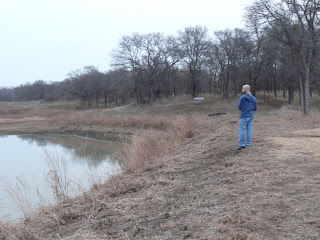




































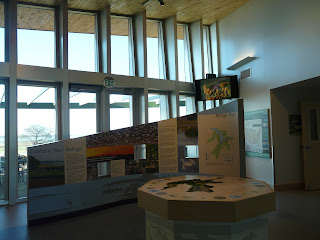

















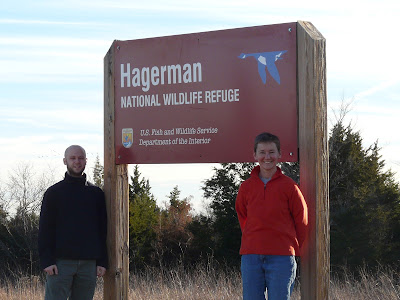






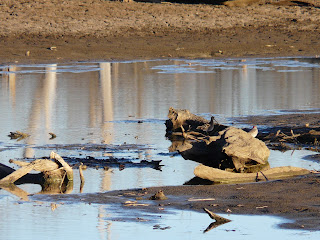

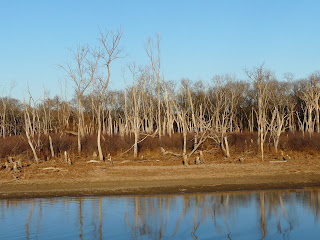



Great tips, many thanks for sharing. I have printed and will stick on the wall! I like this blog. Cabin rentals in az
ReplyDelete